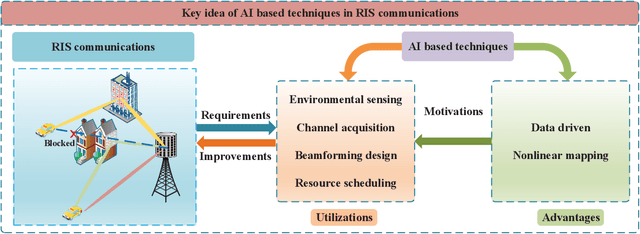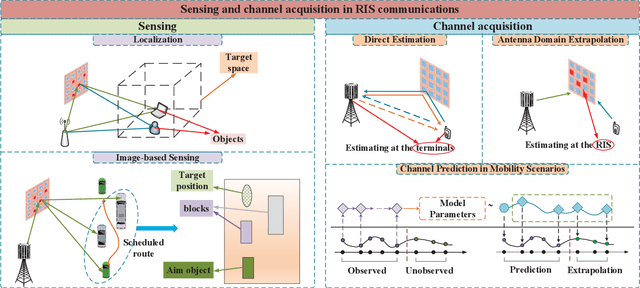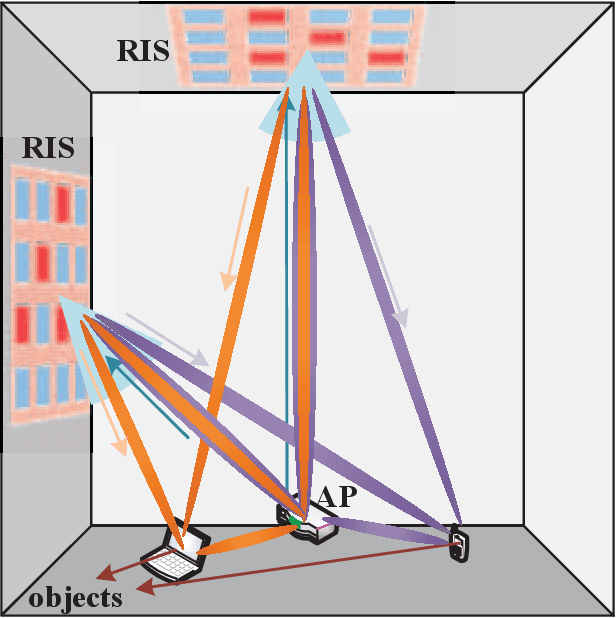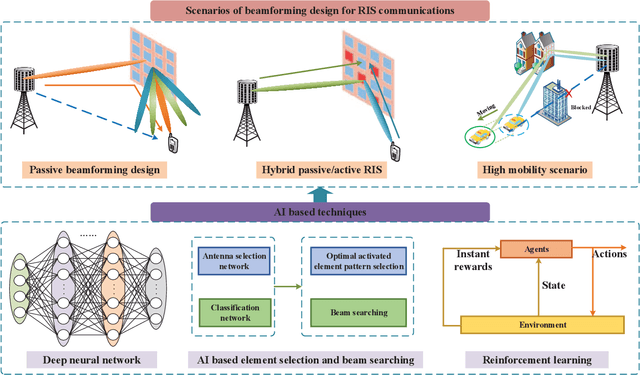Muye Li
STAR-RIS Aided Dynamic Scatterers Tracking for Integrated Sensing and Communications
Jan 07, 2025



Abstract:Integrated sensing and communication (ISAC) has become an attractive technology for future wireless networks. In this paper, we propose a simultaneous transmission and reflection reconfigurable intelligent surface (STAR-RIS) aided dynamic scatterers tracking scheme for ISAC in high mobility millimeter wave communication systems, where the STAR-RIS is employed to provide communication service for indoor user with the base station (BS) and simultaneously sense and track the interested outdoor dynamic scatterers. Specifically, we resort to an active STAR-RIS to respectively receive and further deal with the impinging signal from its double sides at the same time. Then, we develop a transmission strategy with the activation scheme of the STAR-RIS elements, and construct the signal models within the system. After acquiring the channel parameters related to the BS-RIS channel, the dynamic paths can be identified from all the scattering paths, and the dynamic targets can be classified with respect to their radar cross sections. We further track the outdoor scatterers at STAR-RIS by resorting to the Gaussian mixture-probability hypothesis density filter. With the tracked locations of the outdoor scatterers, a beam prediction strategy for both the precoder of BS and the refraction phase shift vector of STAR-RIS is developed to enhance the communication performance of the indoor user. Besides, a target mismatch detection and path collision prediction mechanism is proposed to reduce the training overhead and improve the transmission performance. Finally, the feasibility and effectiveness of our proposed STAR-RIS aided dynamic scatterers tracking scheme for ISAC are demonstrated and verified via simulation results.
STAR-RIS Aided Integrated Sensing and Communication over High Mobility Scenario
Mar 18, 2024Abstract:Integrated sensing and communication (ISAC) has become a promising technology for future communication system. In this paper, we consider a millimeter wave system over high mobility scenario, and propose a novel simultaneous transmission and reflection reconfigurable intelligent surface (STAR-RIS) aided ISAC scheme. To improve the communication service of the in-vehicle user equipment (UE) and simultaneously track and sense the vehicle with the help of nearby roadside units (RSUs), a STAR-RIS is equipped on the outside surface of the vehicle. Firstly, an efficient transmission structure is developed, where a number of training sequences with orthogonal precoders and combiners are respectively utilized at BS and RSUs for channel parameter extraction. Then, the near-field static channel model between the STAR-RIS and in-vehicle UE as well as the far-field time-frequency selective BS-RIS-RSUs channel model are characterized. By utilizing the multidimensional orthogonal matching pursuit (MOMP) algorithm, the cascaded channel parameters of the BS-RIS-RSUs links can be obtained at the RSUs. Thus, the vehicle localization and its velocity measurement can be acquired by jointly utilizing these extracted cascaded channel parameters of all RSUs. Note that the MOMP algorithm can be further utilized to extract the channel parameters of the BS-RIS-UE link for communication. With the help of sensing results, the phase shifts of the STAR-RIS are delicately designed, which can significantly improve the received signal strength for both the RSUs and the in-vehicle UE, and can finally enhance the sensing and communication performance. Moreover, the trade-off for sensing and communication is designed by optimizing the energy splitting factors of the STAR-RIS. Finally, simulation results are provided to validate the feasibility and effectiveness of our proposed STAR-RIS aided ISAC scheme.
Joint Channel Estimation and Data Detection for Hybrid RIS aided Millimeter Wave OTFS Systems
Aug 14, 2022



Abstract:For high mobility communication scenario, the recently emerged orthogonal time frequency space (OTFS) modulation introduces a new delay-Doppler domain signal space, and can provide better communication performance than traditional orthogonal frequency division multiplexing system. This article focuses on the joint channel estimation and data detection (JCEDD) for hybrid reconfigurable intelligent surface (HRIS) aided millimeter wave (mmWave) OTFS systems. Firstly, a new transmission structure is designed. Within the pilot durations of the designed structure, partial HRIS elements are alternatively activated. The time domain channel model is then exhibited. Secondly, the received signal model for both the HRIS over time domain and the base station over delay-Doppler domain are studied. Thirdly, by utilizing channel parameters acquired at the HRIS, an HRIS beamforming design strategy is proposed. For the OTFS transmission, we propose a JCEDD scheme over delay-Doppler domain. In this scheme, message passing (MP) algorithm is designed to simultaneously obtain the equivalent channel gain and the data symbols. On the other hand, the channel parameters, i.e., the Doppler shift, the channel sparsity, and the channel variance, are updated through expectation-maximization (EM) algorithm. By iteratively executing the MP and EM algorithm, both the channel and the unknown data symbols can be accurately acquired. Finally, simulation results are provided to validate the effectiveness of our proposed JCEDD scheme.
AIRIS: Artificial Intelligence Enhanced Signal Processing in Reconfigurable Intelligent Surface Communications
Jun 01, 2021



Abstract:Reconfigurable intelligent surface (RIS) is an emerging meta-surface that can provide additional communications links through reflecting the signals, and has been recognized as a strong candidate of 6G mobile communications systems. Meanwhile, it has been recently admitted that implementing artificial intelligence (AI) into RIS communications will extensively benefit the reconfiguration capacity and enhance the robustness to complicated transmission environments. Besides the conventional model-driven approaches, AI can also deal with the existing signal processing problems in a data-driven manner via digging the inherent characteristic from the real data. Hence, AI is particularly suitable for the signal processing problems over RIS networks under unideal scenarios like modeling mismatching, insufficient resource, hardware impairment, as well as dynamical transmissions. As one of the earliest survey papers, we will introduce the merging of AI and RIS, called AIRIS, over various signal processing topics, including environmental sensing, channel acquisition, beamforming design, and resource scheduling, etc. We will also discuss the challenges of AIRIS and present some interesting future directions.
 Add to Chrome
Add to Chrome Add to Firefox
Add to Firefox Add to Edge
Add to Edge